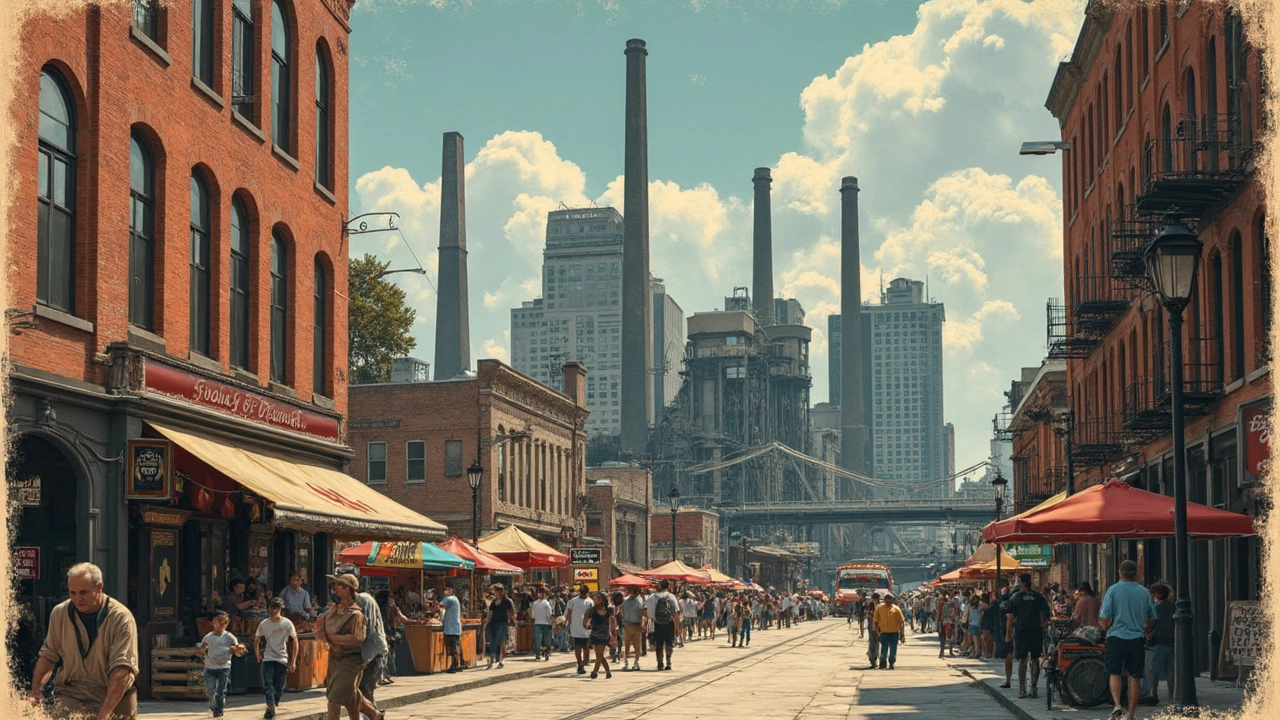What US State is Known as Steel City?

When you think of Steel City in the US, your mind should jump straight to Pittsburgh, Pennsylvania. Yep, nestled in the heart of this state, Pittsburgh earned its nickname for a reason. At one time, it churned out more steel than practically anywhere else on the planet. You might even say steel was pumping through the city's veins.
Steel didn't just build Pittsburgh; it kinda put it on the map. Thanks to its industry roots, Pittsburgh blossomed in the late 19th and early 20th centuries. The city saw rapid growth, and its economy shot up the charts, creating a bustling hub that shaped the America's infrastructure. The soaring factories and smoke-stacked skylines became iconic, making it the heart of American industrial power.
- The Rise of Steel in Pittsburgh
- Impact of Steel on Pittsburgh’s Development
- Steel City Today
- Looking Beyond Steel
The Rise of Steel in Pittsburgh
Back in the day, Pittsburgh wasn't just any ordinary city. It was the epicenter of the steel manufacturing world. This all kicked off in the mid-1800s when the Bessemer Process hit the scene. This game-changing method, which allowed for the mass production of steel, was like pouring rocket fuel onto Pittsburgh's industrial growth.
Andrew Carnegie, the legendary steel tycoon, played a massive part in turning Pittsburgh into the Steel City. By establishing his own steel company, Carnegie Steel Company, he revolutionized the industry with innovations that made steel production faster and cheaper. It wasn't long before Pittsburgh was cranking out steel for everything from bridges to skyscrapers, expanding across the nation and beyond.
Around the early 20th century, over a third of all the steel made in the US came from this very city. That's a mind-boggling amount when you think about it! Here’s a quick look at the steel output during that period:
| Year | Steel Output (Millions of Tons) |
|---|---|
| 1900 | 11.4 |
| 1910 | 24.3 |
| 1920 | 41.6 |
This steel boom transformed the landscape, economy, and even the culture of Pittsburgh. Immigrants poured into the city in search of work. The population exploded, and neighborhoods sprang up around these massive steel mills. So, the next time you hear someone talking about the grit and grind of an industrial city, Pittsburgh is a major part of that story.
Impact of Steel on Pittsburgh’s Development
In the heyday of steel, Pittsburgh wasn't just any city; it was the heartbeat of steel manufacturing in the United States. This industry was the driving force behind the city's rapid development, transforming it from a moderate-sized town into a sprawling industrial powerhouse. The booming steel mills attracted waves of immigrants looking for work, adding to the cultural fabric and population growth of the region.
Pittsburgh's economy was heavily reliant on its steel production. Major companies like U.S. Steel called it home, and these giants had a huge influence on the city's economy, infrastructure, and even its skyline. The city built some of its most iconic structures and bridges with local steel, creating a lasting legacy of strength and resilience.
The jobs provided by this industry were innumerable, fostering a robust middle class and an economic boom that resulted in the development of schools, hospitals, and cultural institutions. Neighborhoods flourished as workers settled, buying homes and raising families. In fact, thanks to steel, Pittsburgh had one of the highest per capita incomes in the US during its golden years.
On an environmental note, the steel mills did contribute to the city's infamous smoky reputation. Thick with industry, Pittsburgh was covered in soot and smoke, which prompted city leaders to eventually implement some of the earliest clean air laws in America. It's a testament to how deeply intertwined the city’s fate and identity were with steel production.
While the global shifts saw a decline in Pittsburgh's steel production by the late 20th century, the impact on Pittsburgh’s development left permanent marks, both good and bad, shaping it into the city it is today.

Steel City Today
Pittsburgh might not produce a titanic amount of steel anymore, but its identity is still heavily intertwined with its industrial past. Despite the decline of traditional manufacturing, the city has reinvented itself while proudly holding onto its Steel City heritage.
Today, Pittsburgh shines as a hotspot for tech companies, educational institutions, and healthcare innovation. The tech boom here is partly due to the growth of startups and the presence of big names like Google and Apple setting up shop. Carnegie Mellon University, famous for its computer science prowess, fuels this tech surge too.
But it’s not all about tech! There’s a noticeable shift towards sustainable practices in the still-operating manufacturing plants. Companies are investing in greener technologies, reducing emissions, and recycling more efficiently. This commitment has put Pittsburgh on the map as a leader in sustainable manufacturing practices.
Living in modern Pittsburgh delivers the best of both worlds. The city embraces change, yet celebrates its history through places like the Carrie Blast Furnaces National Historic Landmark and the Rivers of Steel Heritage Area. These spots offer glimpses into what once was the pulse of America’s industrial life.
Even though steel production isn't what it used to be, Pittsburgh's heart and resilience continue to be shaped by its iron-willed legacy. Residents enjoy a balanced lifestyle with access to cultural venues, stunning parks, and a thriving food scene. It's a mix of new-age advancements and a strong, historic backbone.
Looking Beyond Steel
So, what's Pittsburgh up to these days if they're not the steel powerhouse they once were? Well, the city's got a new vibe going on. While steel might still be a part of its DNA, Pittsburgh is now all about innovation and sustainability. The city embraced transformation, diving headfirst into the tech world. Think of it like this: what Silicon Valley did for tech, Pittsburgh is doing with its own flair.
Major companies in robotics, healthcare, and information technology have popped up all over, bringing in new energy. Carnegie Mellon University and other research powerhouses have been central in steering Pittsburgh towards becoming a tech hub. Keywords still matter, especially when talking about this city's ability to adapt and grow beyond its steel days.
"Pittsburgh is an example of a city that's reinvented itself effectively in the post-industrial era, offering lessons in resilience and innovation." — The Atlantic
Besides tech, Pittsburgh is drawing in the medical industry, with the University of Pittsburgh Medical Center (UPMC) leading the charge. This shift has not only kept the city alive but has breathed new life into its neighborhoods. Wander around today, and you'll find a mix of modern and historical architecture, quirky cafes, and community-driven projects.
Pittsburgh didn't just sit around and wait for someone else to shape its future. It's a city that rolled up its sleeves and got to work on crafting a new identity. A city defined by its strong past and a future that’s just as promising—if not more. There's a lesson here for anyone watching: reinventing isn't just possible, it's happening right now in Steel City.





